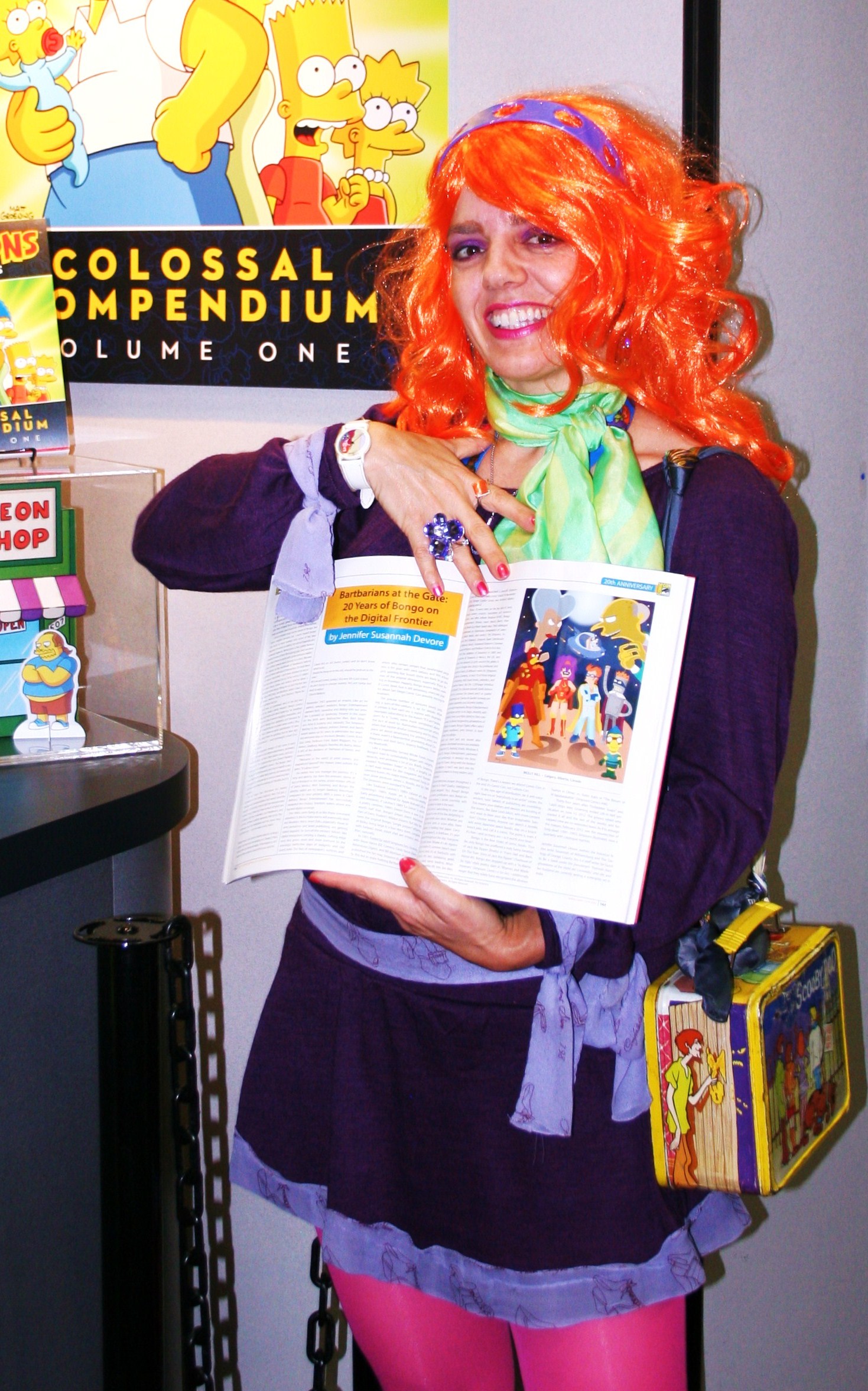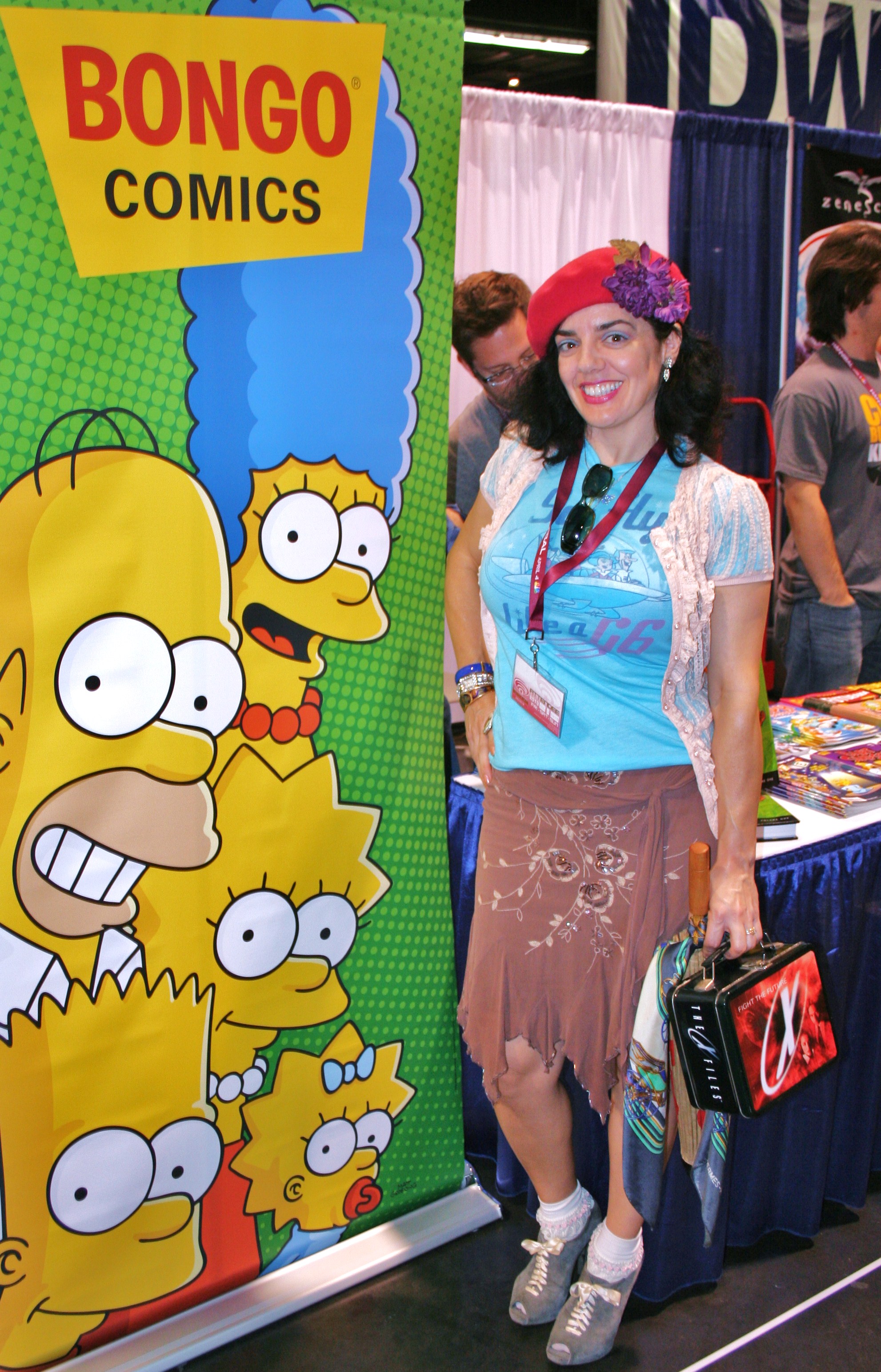No matter how you manage the journey, it’s a long and sketchy trip from the overcast, damp alleys of Portland to the sunny, ocean-misted offices of Santa Monica. Matt Groening and Bongo the Überhip Rabbit are no longer hawking Macintosh computers for laser printers. With a Lewis & Clark deftness, Bongo Entertainment has successfully navigated the choppy, brackish waters where analog and digital converge.
The 1990s came flying at us like those imminent asteroids Dr. Michio Kaku warns will eventually slam into Brooklyn. Many smart folks, especially those in print journalism and book publishing, are getting nailed regularly by turn-of-the-century fallout, like digital mosquitoes carrying a cheeky, cutting-edge virus which grows more and more immune to the amusingly ineffective slaps of indignity and Old Guard pride. The likes of newspapers, authors and artists who remain certain newfangled progress is for guys with neck tattoos and film school girls sporting Boy Scouts shirts, are likely to go the way of the original dinosaurs, especially those living in Brooklyn. Happily, Bongo knows better, even if Comic Book Guy is still lamenting years-old chatter about San Diego Comic-Con possibly moving to Anaheim.
The precise number of ventures poorly judging a turn-of-the-century is up for debate. Victorian gas proprietors loathed Thomas Edison as much as the fading Vaudevillians did. John Henry fought tooth and railroad nail against the steam engine, whilst across the Atlantic, Luddites vilified machines taking labor from textile artisans. The 21stC. Technological Revolution is no different, in theory, than the 20thC. Industrial Revolution. In both wakes lie more dead ideas and failed executives than Jack the Ripper had bad dates. (R.I.P. Kodak Film and Thomas Bros. Guides)
What is certain is that each era is replete with dogmatic examples subscribing to the maxim: “If it ain’t broke, don’t fix it.” Surely, some monk complained about the lack of work for illuminated-manuscript artists when that hipster doofus Gutenberg and his skinny jeans set about developing the printing press; and if there wasn’t a Neanderthal grumbling about Cro-Magnons and their fancy, sloping foreheads, I’ll eat my Bluetooth.
Like responsibly farmed, Whole Foods mussels, Bongo’s road to sustainability began with integrity, tenacity and probably a lot of ice. Briefly, Groening created "Forbidden Soaps" in 1978, a lengthy, Life in Hell soap review for Wet magazine and founder Leonard Koren. His soapy stories seduced Tracey Ullman Show producer James L. Brooks and by 1989 The Simpsons were standard TV fare.
Like Toulouse Lautrec’s 1880s cabaret art, Matt Groening’s 1980s Apple art is collector-worthy. Early advertising material for Apple featured Life in Hell residents. If Lautrec’s 1889 La Danse is worth a pretty centime, 1989’s Dream Dorm is sure to be worth half that. Bongo’s Dream Dorm: Macintosh. Part of Every Student’s Wildest Dreams (full title) features the original Bongo, “jungle passion” offspring of Binky, living large in a four-story dorm, complete with helipad, moat, robot chef, pet octopus and a Mac, naturally.
In 1991, fueled by rabid Simpsons fans, Groening with Steve Vance (DC Comics), Cindy Vance (Disney Adventures Digest) and Bill Morrison (Futurama) co-published the fan mag, Simpsons Illustrated. Naturally, this led to more frothing Bartbarians at the gate and in 1993 they published a one-off: Simpsons Comics & Stories. Finally crying Uncle! in November 1993, Bongo Comics Group was birthed: slippery Spiderpig and all.
Today, twenty years later, on the hip side of Santa Monica where crunchy, lunchtime surf sessions beckon, and after infinite Pantone #116C, Bongo Entertainment thrives, more Monty Burns than Comic Book Guy these heady days. Their catalog encompasses an impressive compilation of calendars, trade books and comics: Futurama, Simpsons Classics, Summer Shindig, Lisa, Milhouse, Krusty, Futurama/Simpsons Crossover, Treehouse of Horror and Professor Frink to list a few.
Adding Futurama in 2000 and with reprints of Simpsons in Mexico, the U.K. and Australia, the amount of print around the globe is growing at a fungal rate. Bongo has produced and distributed at least twenty different series for Simpsons comics alone. Currently, at least ten of those original titles are ongoing. Add trade books, calendars and the occasional beast, like the 1,200-page omnibus Simpsons World: The Ultimate Episode Guide Seasons 1-20, and it’s a wonder the streets aren’t as coated with Bongo mags as Charles de Gaulle’s runways are with Gauloises cigarettes and absinthe bottles.
Like any sage impresario, Bongo Entertainment has brought fellow artists to its stage, recently adding Spongebob Comics and Mylo Xyloto to their catalog. Moreover, to please burgeoning generations of readers allergic to paper, Bongo Digital offers select issues alongside traditional, print format: at least two per week, they pledge.
Although you must wait one month after newsstand-release, download versions are available via comiXology for iOS, Android, Kindle, Windows 8 and Windows RT. Bongo Entertainment partnered originally with comiXology to develop the Simpsons Comics app for iTunes. Along with the freshest issues, Bongo pledges to reach way back into the dairy case of archived content to bring readers tasty treats from the past.
How does an enterprise prosper throughout a lifespan of Apple IIe to iPad5? Quality, intelligence and old-fashioned zeitgeist. Plus, though Bongo Digital makes instant gratification easy, Bongo understands there remains a tactile courtship with comics that is unlikely to fade in the wash.

If you’re Old School, subscribing to your comics via Snail Mail, you’re one of the few delighting in a fed outside your door. Whether you haunt your local comic storeor scour eBay, there is visceral happiness in holding that paper. Carrying it in your purse, backpack or briefcase, it’s your secret to be enjoyed throughout the day. Everyone has a ritual with a new issue. Maybe it’s de rigueur for business flights; maybe it’s summer beach reading. If you’re proud and loud, it’s at Starbucks with an espresso. If you’re the rare, outdoorsy geek, Treehouse of Horror is great, camp reading. Whatever your liturgy, it helps breathe life into the likes of Bongo. There’s a reason we attend Comic-Con; in the end, it’s Comic-Con, not Culture-Con.
In the new age of distribution, be it anti-copyright love-ins, or "everybody-is-an-artist" curses, the ancient, runic tablets of publishing are crumbling. This means your shelves and devices are bursting at the seams, like Slave Leia’s bikini, with more content and ways to blow your day than imaginable. Solution? Choose wisely. Anyone can sketch a doodle, add some Japanese space boobs, slap on a knock-knock joke and call it a comic. The point is, even if it’s free –and so many are- is it worth your time?
Bongo is the New Yorker of comic books. Thus far, only Bongo has proffered a truly funny iteration of Jack the Ripper (finally) in From Hell and Back, Or: The Truer Story of Jack the Ripper (Treehouse of Horror #9). Bongo also stepped up with a “Yo Mama So Ugly”-style poetry slam in Rhymes and Misdemeanors (Simpsons Comics a Go-Go). I additionally wager they solely have recognized the obvious humor in Olmec vs. Aztec traits in The Return of Xt’tapalatakettle (Simpsons Comics #98).
Thirty-four years after "Forbidden Soaps" and 1,669 strips later, Groening ended Life in Hell syndication on June 15, 2012. The groovy rabbit who started it all and the rest of the wonky and fez-capped crew are on extended leave. As if to assuage the masses, February 2012 saw the resurrection of long-dead (1991-1993) Simpsons Illustrated: now a quarterly with catalog reprints.
Choose intelligently, folks; there's a lot of shlock out there. Anyone can pick a comic book worthy of T&A; pick one worthy of an M.F.A.
Reprinted from the official SDCC 2013 Souvenir Guide
Read all my SDCC Souvenir Book articles here!
Follow @JennyPopCom Twitter and Insta
JennyPop's Amazon Author Page, to boot!




